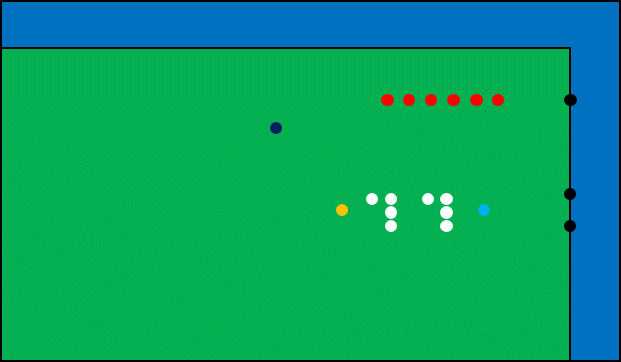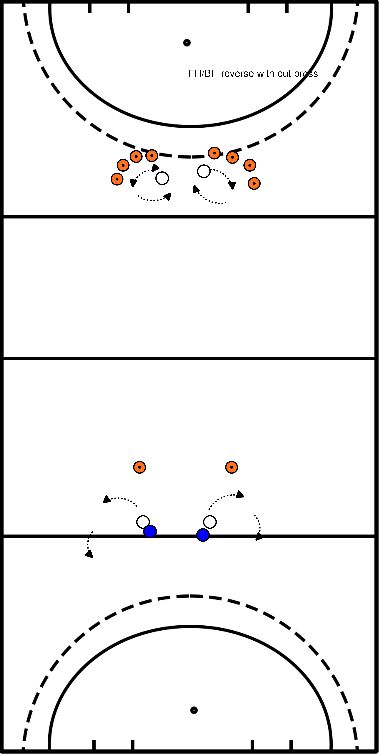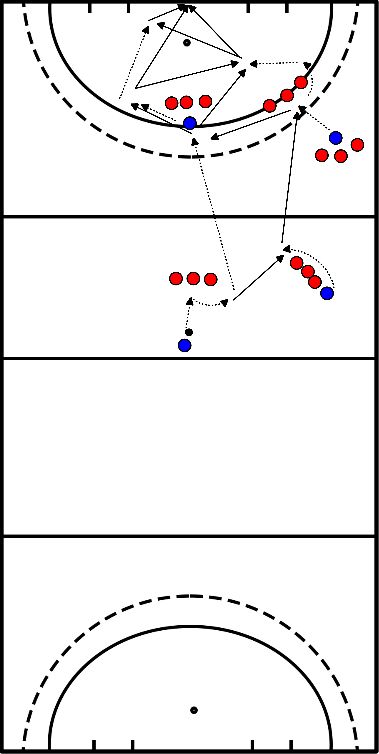Hockey drills for technique pass around player
- 3 persons stand at the pilons and try not to let the player in the middle touch the ball.
- It is important that the diagonal pass is not made possible.
- So the players without the ball have to stand in the corners compared to the player with the ball.

Game with different variations:
- with grip
- with globe
- with stick in weird position
- with other balls
- Player A runs left towards the pilon straight ahead and retrieves the ball so that the pilon is played out.
- Then player A passes the ball deep on to player B, who runs in.
- Player B puts the ball back to player A
- Player A finishes.
Then player A does the task of player B and vice versa.
- Player A plays the ball to Player B, who comes running into the ball.
- Player B bounces the ball directly back and runs towards the corner edge circle with a slalom through the gates.
- Player A runs towards the first pole to perform a tip in
Exercise is set up in the middle.Player A becomes player B and vice versa.
- Each player takes a pilon.
- Fields of about 10x5 are made.
- The pilon is placed in the middle of the back lines.
The aim is to play past your opponent and dribble the ball over the pilon. IT IS NOT ALLOWED TO SHOOT FROM 10 METERS!
The winner goes one square to the right and the loser goes one square to the left. Rounds of -/+ 2 minutes
Aim
- Practicing some useful hockey techniques.
Set up
- The player starts at the top black pilon.
- He/she goes through the red slalom and then dribbles towards the (dark) blue pilon.
- From the (dark) blue pilon an Indian will follow
- Dribble to the yellow pilon.
- This is followed by passing moves, in this case a drag has been chosen.
- With other movements, the pilons may have to stand slightly different.
- But here the player runs to the left (end of the L) and drags in front of the 3 pilons the ball forcefully to the right.
- This is repeated again and then the player pushes the ball onto the black goal.
- This exercise can be made easier/complicated. E.g. by changing the passing movements, increasing/reducing the distance of dribbling, making the goal smaller/ larger, adjust the slalom slightly, etc. etc. You can really let your own imagination run wild.

- The trainer (T) rolls the ball (1) to one of the four front players (for example A).
- Player A receiving the ball (2) plays a duel with player V1 opposite him.
- The goal is to score the ball at the opponent's goal.
- If V1 manages to intercept the ball, he plays it to V2.
- Now V2 may try to score with player B.
- After a goal, the form of play starts over again.
Making it easier
- Play a 1-1 duel on the two fields for a few minutes, after a goal, the substitute player comes into play.
Make it more difficult
- After the ball is taken by V1, V1 and V2 may try to score against player A (now it has become a 2-1 game).
- A has to defend.
- If A takes the ball, he plays it to player B.
- Player A and B play a 2-2 duel on players V1 and V2.
- It works just like a normal game only now there's a square in the middle.
- If a shot or other foul is made, or if the ball has been out of bounds, the trainer throws/plays in a new ball from inside the square.
- The ball does not necessarily go to the same team or at the place where the foul was made.
- The size of the field depends on the number of players.
- Set up hats/pilons in such a way that they resemble a frying pan with a handle.
- The children are the eggs and dribble with the ball around the frying pan, they can always walk over the handle.
- The tagger is the cook, who likes to fry a delicious omelet with 3 eggs.
- So the cook tries to tag 3 eggs but is only allowed to walk over the handle 3 times.
- Each tagged egg is placed in the frying pan.
- How long does the cook need to tag the 3 eggs?

- Player A dribbles the ball to the next pilon and then plays the ball to player B.
- After playing the ball player A runs to player B's place.
- Player B does the same and plays the ball to player C.

- receive the ball either forehand or backhand,
- receive with a forehand and turn quickly to your left side.
- receive with a backhand and turn quickly to your right side.
- While under pressure:
- receive on the side were the defender is positioned, turn away quickly and speed up

- The centre mid runs in towards the defender (red) he plays the ball to the right half, who runs into the free space
- The centre mid runs forward.
- Right half plays the ball between the defenders to the right front who comes running in between the defenders.
- Front right passes te ball to the left and goes past the defender and runs in the circle.
- The centre mid now has two options that influence finishing:
- 1: he plays the ball to the striker to the left within the circle area.
- Striker plays directly on goal OR crosses to the right front (and runs towards the front of the second post).
- 2: he plays it to the right of the central defender on the right front player.
- Right front attempts to shoot directly on goal OR passes towards to second post, striker tips it in.
- 1: he plays the ball to the striker to the left within the circle area.
- Tip: Because the game can change depending on choices, communication is key!
- Indicate where you want the ball and shout to whom you are playing it!








